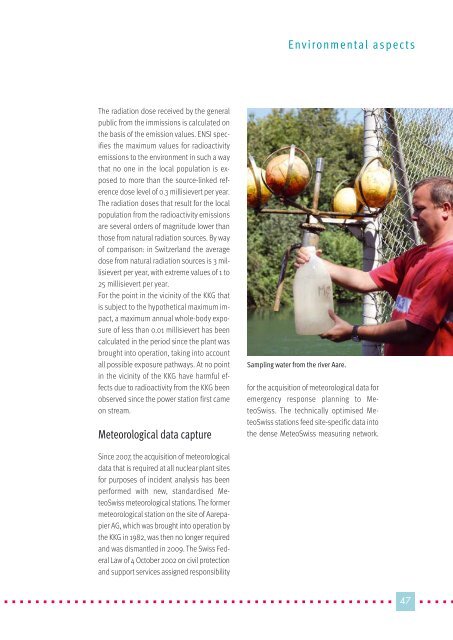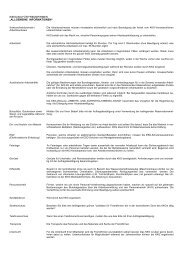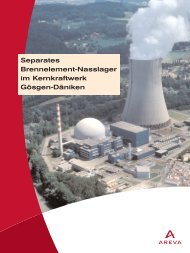Technology and Operation - Kernkraftwerk Gösgen
Technology and Operation - Kernkraftwerk Gösgen
Technology and Operation - Kernkraftwerk Gösgen
Create successful ePaper yourself
Turn your PDF publications into a flip-book with our unique Google optimized e-Paper software.
The radiation dose received by the general<br />
public from the immissions is calculated on<br />
the basis of the emission values. ENSI specifies<br />
the maximum values for radioactivity<br />
emissions to the environment in such a way<br />
that no one in the local population is exposed<br />
to more than the source-linked reference<br />
dose level of 0.3 millisievert per year.<br />
The radiation doses that result for the local<br />
population from the radioactivity emissions<br />
are several orders of magnitude lower than<br />
those from natural radiation sources. By way<br />
of comparison: in Switzerl<strong>and</strong> the average<br />
dose from natural radiation sources is 3 millisievert<br />
per year, with extreme values of 1 to<br />
25 millisievert per year.<br />
For the point in the vicinity of the KKG that<br />
is subject to the hypothetical maximum impact,<br />
a maximum annual whole-body exposure<br />
of less than 0.01 millisievert has been<br />
calculated in the period since the plant was<br />
brought into operation, taking into account<br />
all possible exposure pathways. At no point<br />
in the vicinity of the KKG have harmful effects<br />
due to radioactivity from the KKG been<br />
observed since the power station first came<br />
on stream.<br />
Meteorological data capture<br />
Since 2007, the acquisition of meteorological<br />
data that is required at all nuclear plant sites<br />
for purposes of incident analysis has been<br />
performed with new, st<strong>and</strong>ardised MeteoSwiss<br />
meteorological stations. The former<br />
meteorological station on the site of Aarepapier<br />
AG, which was brought into operation by<br />
the KKG in 1982, was then no longer required<br />
<strong>and</strong> was dismantled in 2009. The Swiss Federal<br />
Law of 4 October 2002 on civil protection<br />
<strong>and</strong> support services assigned responsibility<br />
Environmental aspects<br />
Sampling water from the river Aare.<br />
for the acquisition of meteorological data for<br />
emergency response planning to MeteoSwiss.<br />
The technically optimised MeteoSwiss<br />
stations feed site-specific data into<br />
the dense MeteoSwiss measuring network.<br />
� � � � � � � � � � � � � � � � � � � � � � � � � � � � � � � � � � � � � � � � � � � � � � � � � � �47 � � � � � � �




